For normal livelihoods in the house or in the country there should be constantly water. Most often sources are well or well. Preferably well. First, because they are achieved, as a rule, there are quite deeply airing aquifers with cleaner water. Secondly, they serve longer. Third, the flow rate (speed replenishment) is significantly higher. It is also important that it is possible to drill wells on the water with their own hands. There are several technologies, you just need to choose.
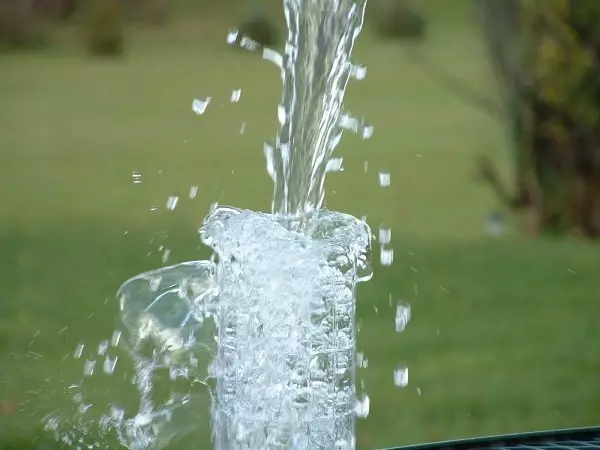
Water near the house is always good
Ways of self-drilling wells for water
Boreholes on Water Buryat or scoring - different technologies involve different ways. Drilling wells on the water with their own hands is possible far from all the methods, but some use is real.Screw drilling
With this technology, the well is done using a special bora - auger. This is a steel pipe, with woven spiral blades. When rotating, the projectile is immersed in the ground. After he leaves all his depth, it is taken out, the soil remaining on the blades is poured. The auger is again lowered into the well, making the pipe from above, continue the recess of the soil. So, once after time removing the shell and shaking the soil, the well bundle. Pipes at the ends can have a thread or connect with spills.
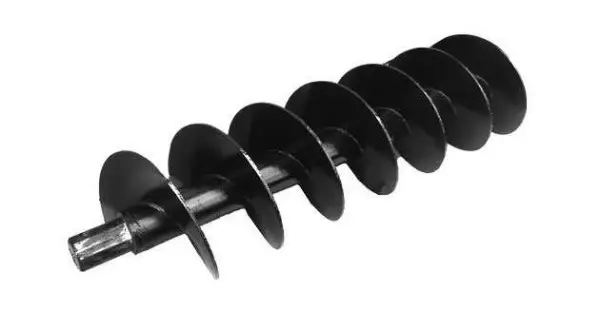
So the screw looks like
The lack of this method is not suitable for all types of soils. Normally grope soft or middleness of the hardness of the breed. If the rocky or rocky layer is found, the work will be ineffective - the auger here is powerless. In bulk soils will be observed, which is also problematic.
According to this technology, quite powerful installations work, but there are even manual screw storms. They work very hard, but perhaps. There is a simple device that makes the screw drilling of wells on the water with their own hands easier - this is a tripod with a gate and strengthened at the top of the block. With the help of a cable, winch and block it is easier to get a drilling projectile, and it is necessary to do it often.
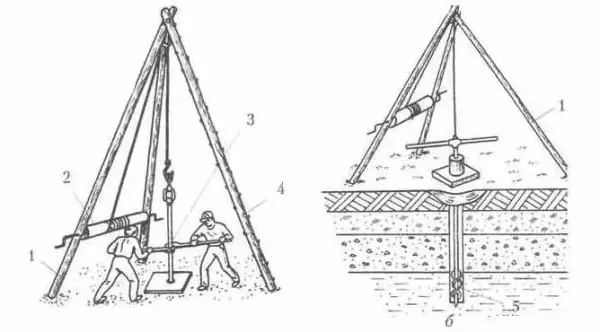
Hand drilling rig
More convenient motorized drilling installations, and not necessarily purchased. There are interesting homemade. In any case, this is a frame with a moving fixed motor, which leads to the drill. An example of such an installation in the next video. The screw boring is used not for water wells, but the essence of the installation itself and the principle of operation does not change.
With small sizes of a screw and a rod, which increases length (up to 1.5 m), this method of drilling wells can be used in the house, dachas, baths. The main thing is that the soils are suitable.
Watercading (using pump or pump)
As it is clear from the title, this method uses water to drill wells. With independent use, the water is most often supplied to the tube. It comes out through the special holes at the bottom of the bora, flows out of the gap between the outer wall of the pipe and the walls of the well.
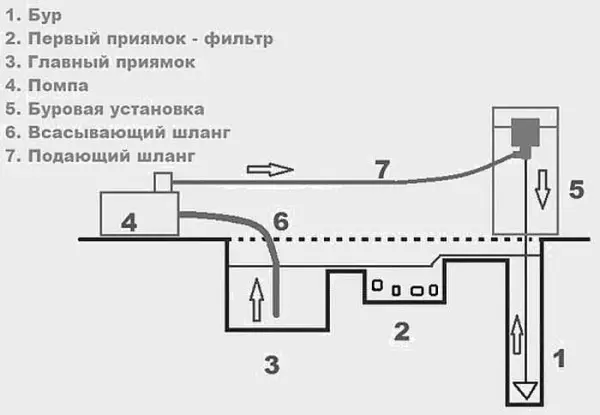
Scheme of the organization of the waterbound
In addition to the bora and pipes with a thread for this method, a pump is still necessary. Before starting work near the future well, two pites are equipped. In the first, the main amount of soil is deposited, in the second water, devoid of most impurities. Water for the process must be a bit - it is constantly circulating. From the first pit, periodically precipitation is usually cleaned with a symptoms. If necessary, if the water has become too dirty, it can be replaced. It is pumped out with the help of the same pump, just do not serve in the well, but merge somewhere on the site. Bay a new batch of water can be drilled continue.
After the well reached the required depth, there is a casing with a filter at the end. Recently, the PND or PVC pipe is most often used. With PND, it is easier to work - it beats well. The filter is holes, twisted at the end of the casing. The length of such a filter is about a meter. Then, on top you can wind the wire from a stainless steel, and on top of a small grid from the same stainless steel.
Article on the topic: Repair of laminate without disassembly: how to make it yourself
Shock-rope method
One of the easiest ways to make a well to make a well independently - shock-rope. But he and the slowest, in the absence of mechanization, requires significant physical efforts. On the other hand, it can be viewed as a simulator. And very effective - almost all body muscles work.
Shock-cable drilling of wells on the water with their own hands is a universal method that can be used on any kind of soils. Only a projectile is changing, and the technology and installation remains the same:
- On clay and other incomprehension soils, a thick-walled metal pipe segment is used, at the end of which the cutting edge is made, bevelled inside. It is also called the Bur-glass for the characteristic form. It is easy to make it yourself. The main thing is to find a pipe with a thick wall (the thicker, the better). It remains sharpened by the lower cutting edge, make slots in the sides (for easy removal of the soil), and at the top of making "ears" for fastening the carbine and cable.
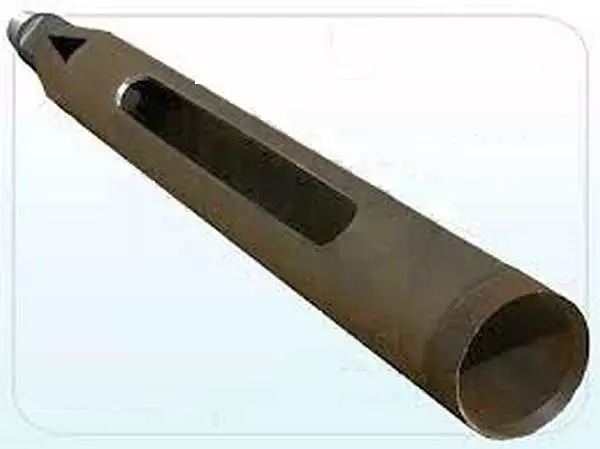
Shell for shock-rope drilling
- In the layer of bulk breeds - rubble, sand - uses ulutes. This cut pipe for the bottom of which is welded spring-loaded valve. When you hit the valve opens, the soil falls inside the pipe. When lifting under the action, the weight of gravity valve closes, not giving out the breed.
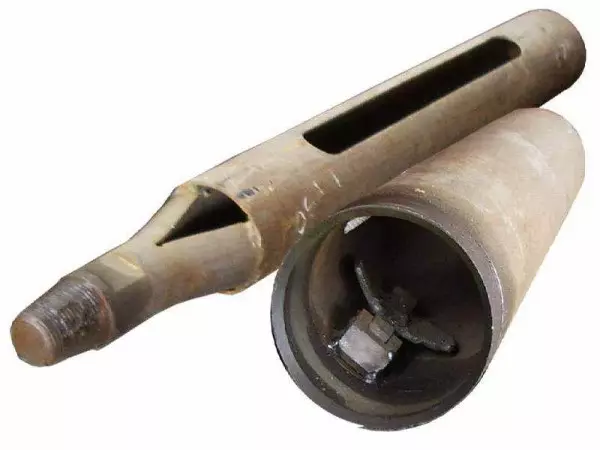
Iron with valve for bulk soils
- In the same soils, it is sometimes more efficient to use a born spoon. It is so named for the specific shape of the lower part - two bent towards each other petals.
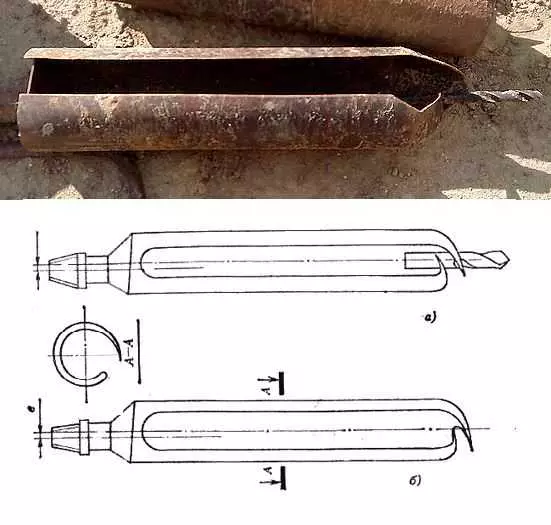
Bur-spoon for viscous soil
- On rocky rocks used drill bit. First, the breed is crushing, then removed using one of the shells described above - how convenient, so work.
The installation of cable drilling can be performed in different ways. The most common type of tripod, in the center of which is fixed block. But the block can be attached to the M-shaped structure, an electric motor with a gearbox can also be used to facilitate labor.
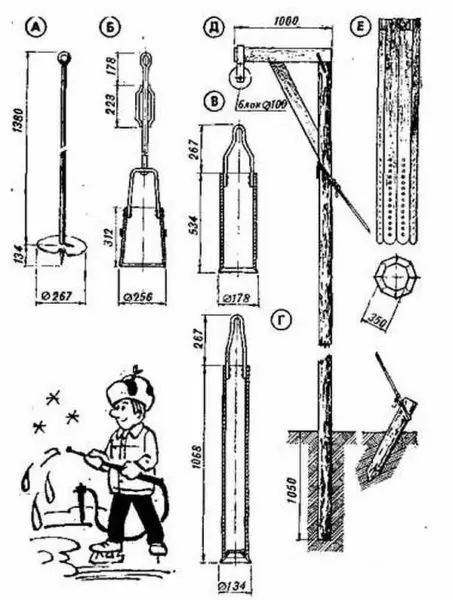
The design of the shock-cable setting in the form of a M-shaped rack
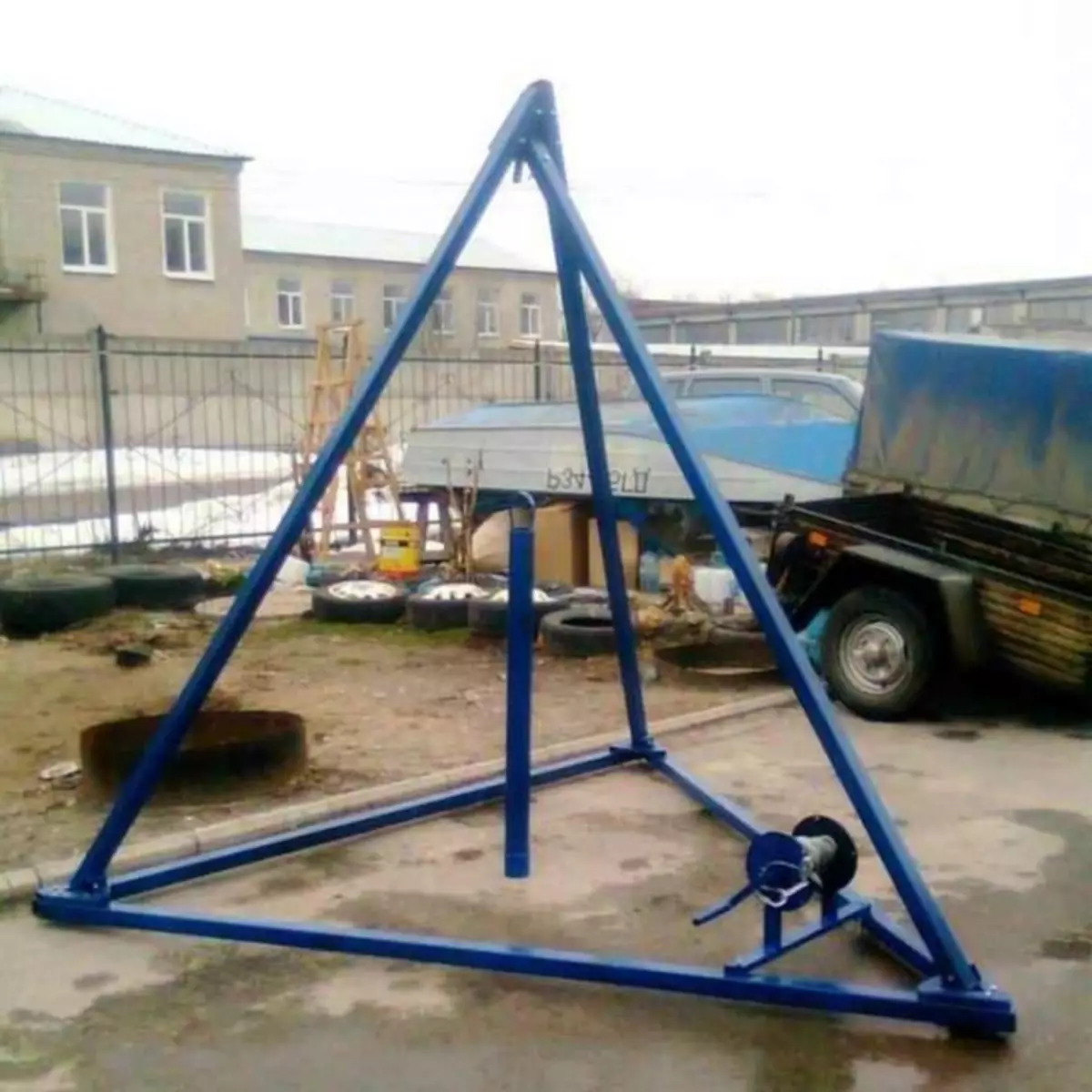
Trenoga - the most common type of installation
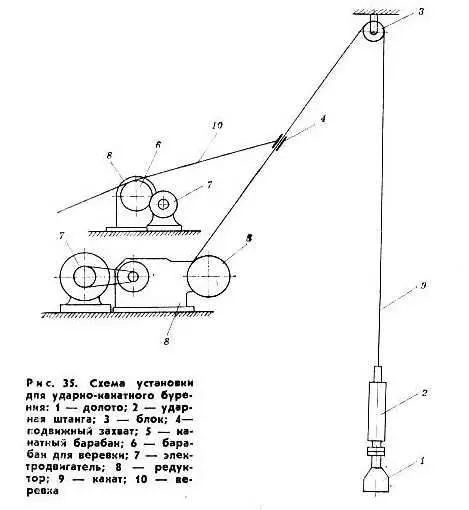
Method of mechanization
The technique of shock-rope drilling is very simple: the projectile is raised, they are released into a free drop. So repeats many times. With each blow of the well becomes slightly deeper. When the plot of 50 cm passed, the projectile is removed, free from the soil. And everything is repeated again.
So that the drilling went faster, a heavy projectile is required. If the walls of the pipe are thick, mass and so may be significant. If necessary, you can drag - pour lead the top of the pipe. Also, to accelerate the passage, the lower edge can be sharpened, but it is necessary to do this so that the SCOS is directed inside. Another point: Pay attention to the slots in drilling shells. They facilitate the removal of the breed. This is especially important when passing dense, viscous clay layers.
The cable for shock-cable drilling rig is needed with a diameter of 10-12 mm. If you work manually, gloves are needed. When passing the upper layers, it is easier to use a manual boring, and for easier passage of the upper layers on a dry time, you can pour water into a bored well.
Casing and filter
All described technologies of independent drilling of wells for water have common features. After the well reached the aquifer (water will appear in the breed in large quantities), for some time they continue to be drilled, deepening in the depths of the waterproof by 1-2 meters. Then the entire drilling projectile is disassembled, and the casing is installed inside the well.With a casing should be sorted out. Diameter Select Depending on how you dried a well and from the type of pump that you plan to use. We must carefully refer to the choice of material. For some time asbestos pipes were used for the casing. But they are very harmful - the strongest carcinogen. It is not necessary to use galvanized pipes - zinc from the body is not displayed, accumulates. And the poisoning them has very bad consequences.
It remains not such a large selection - pipes made of steel and stainless steel, as well as plastic - PND and PVC. Stainless steel - almost perfect option, except for the price and complexity of welding. So that the seam does not rust requires welding in an argon medium, but it is not easy. Although special electrodes for welding stainless steel can be helped to some extent.
In recent years, plastic pipes have become increasingly popular. PVC and PND - cheap and angry, but for their installation, the well should be perfectly smooth. Another point - plastic does not very well tolerate the load. Because it is possible to use them at a small depth - meters to 15. In any case, the sewage pipes should not be installed for the well, it is still better to find a plumbing, although they are more expensive: the walls in them are different thickness, so the attachments are justified.
Steel pipes will definitely not sleep and preserve long, but also have a significant drawback: they rust. However, from the options described above, metal is optimal, if there are no stainless steel products.
Water entered inside the casing tube, in its lower part, which is immersed in the aquifer, make a filter. In the pipe make holes. There are two options. The first - a drill of a large diameter, in four rows in a checker order. The second is cut through the longitudinal slots (size 1.5-2.5 mm).
On top of the pipe coat the wire (3-4 mm in diameter), and the grid with a very shallow cell is fixed on top of it. It is best to use stainless steel. In this case, you can wash the filter from deposits using flushing solutions, and the wire and the grid can be welded to the pipe.
If you use any other metal, after a while the filter fails. Black metal rusts, the rest are destroyed due to electrolytic corrosion.
Abyssinian Well or Well-needle
This kind of manual drilling of wells on water and drilling will not call - a special rod with a cast cone-shaped tip is clogged into the ground, increasing as the trumpets-rods (length of one 1-2 meters), which are connected using threads. Call this type of wells in different ways, scoring, Abyssinian, needle. All this is about one method.
The difference from all other methods is that these pipes remain in the ground, water will be received. That is, this is a well without installing the casing. It is pierced with these pipes, they are then used. Therefore, as a rod, which increases the needle, use water pipes with a thick wall. Diameter from 25 -32 mm. Since pipes are clogged forever, their connection must be sealed. Traditionally, to improve reliability use winding (usually linen), it is possible to deprive it with a sealant.
The first element of the Abyssinian Well is called a needle. But the peak tip is far from the only difference of this part from others. Almost the entire length of the pipe is inserted in it holes. This is a water filter. Through them, water will come inside. So that they are not clogged by the breed, over the pipe spiral winding the wire, and the fine mesh is fixed on it. So that the well served a long time, was not clogged, there was an opportunity to make washing, wire and grid should be stainless steel. Only in this option serve the filter will be long and without problems. The use of other metals, albeit stainless, much reduces the life of the well - the metals are destroyed by electrolytic corrosion. Therefore, brass, copper or any other wire or grid on the steel pipe are not suitable.
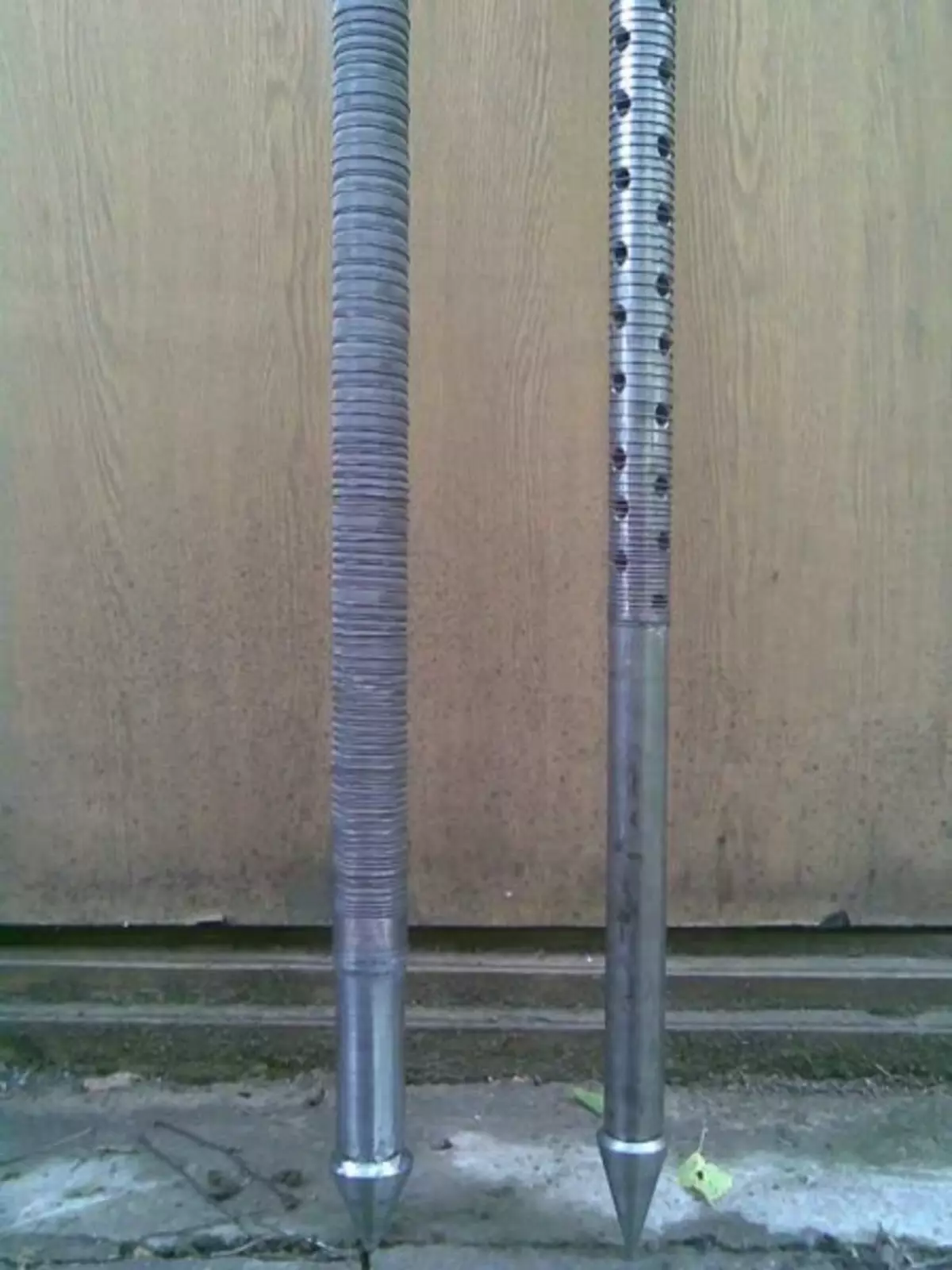
The first element of the Abyssinian Well - a needle with a tip-peak and filter
Another point. In order for the grid and winding while clinging, they are welded to the pipe. The next moment: the diameter of a wide part of the cone should be wider than the diameter of the pipe. When clogging, the cone leaves a hole of a greater width than the pipe with winding, therefore it does not force it.
The process of scoring the well-needle is extremely simple: beaten through the pipe, driving it into the ground. But if you knock on something heavy along the top of the pipe, it is deformed. Therefore make a special device - a grandmother and a cone that screws into the top of the pipe. Inside the grandmother, the shock surface also has a cone shape. The existing cavities inside are poured by lead - to increase weight. The more weighs the projectile, the faster the pipe will be clogged, but keep in mind that it is necessary to raise it with your hands and very many times.
Baba itself in diameter is much larger than the pipe that will score. So that when it is moved, there is no backlash at the bottom, the washer of a suitable diameter is installed (slightly larger the outer diameter of the pipe). As a result, the grandmother freely walks up / down, but without any backlash. The height of the lifting of the projectile is determined by its dimensions - it is necessary that it does not fly from the clogged pipe. The appearance of the grandmother to drive the Abyssinian Well and its drawing are located below.
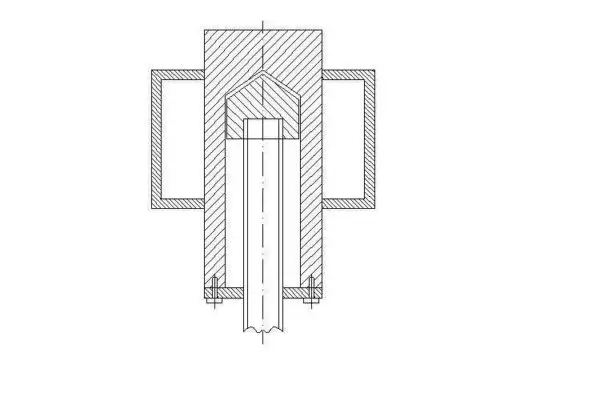
Grandma for clogging a well-needle in the context
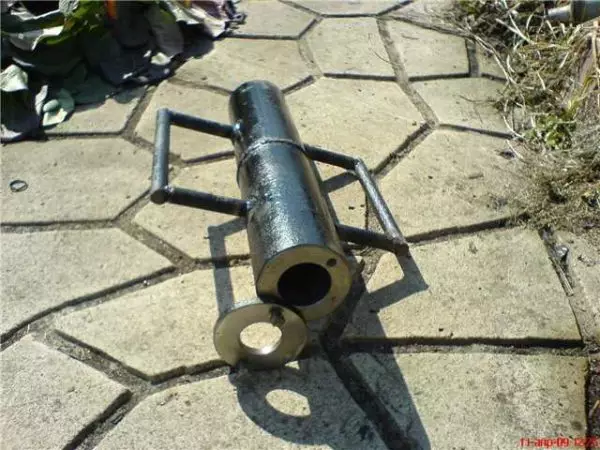
So looks like a shell for scoring well
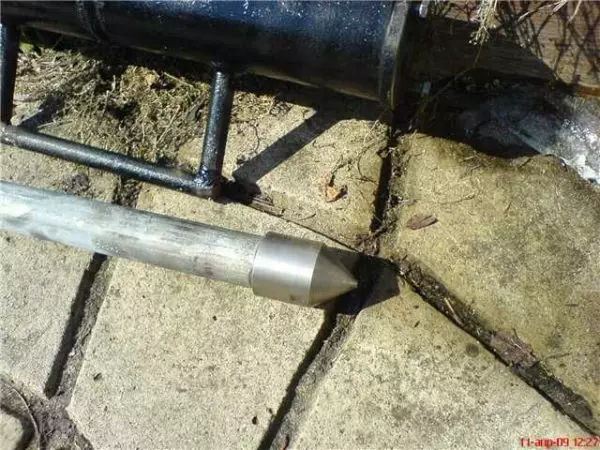
This is a cone for centering efforts
This is not the only device, with which the wells are clogged. Make a powerful clamp on the pipe, which is fixed according to the clamp principle. Instead of grandmother, use a heavy metal ring with two handles. How to work with them - look in the video.
As you can see, it is possible to break the well on the water and inside the house or even at the bottom of the old well. Not much place it is necessary.
How to equip a wellbore
Punch / dried well not enough. It is necessary to raise the water, and this is a completely different story. How to spend water from the well to the house read here. If you want to make water permanent, with normal pressure, so far can be connected to the household appliances, you will need a pumping station.
For seasonal water supply in the country, it is possible to do with a more modest set:
- vibration pump;
- Check valve that is installed in front of the pump;
- water tank;
- watering hose;
- Cranes, etc.
Please note that the check valve is installed before the pump, and not at the end of the hose immersed in the well. Just this very hose during freezes will not break. Another plus of such a device is easier to dismantle for the winter.
Another advice: a well need to close something. In the houses of permanent residence, the caisson is made - a concrete or plastic bunker, which is below the drainage depth. It puts all the equipment. When using water, only periodically caisson is too expensive. But it is necessary to close the well. First of all, some living nature may fall into it, which will not please you. Secondly, the "good" neighbors can drop something. More budget exit - to build a house on the type of well. An even cheaper option is to dig a pit, climb his board, make a militant lid. Key point: All this should be shoved to the castle.
Article on the topic: A raft with your own hands for alloy on the river and fishing
